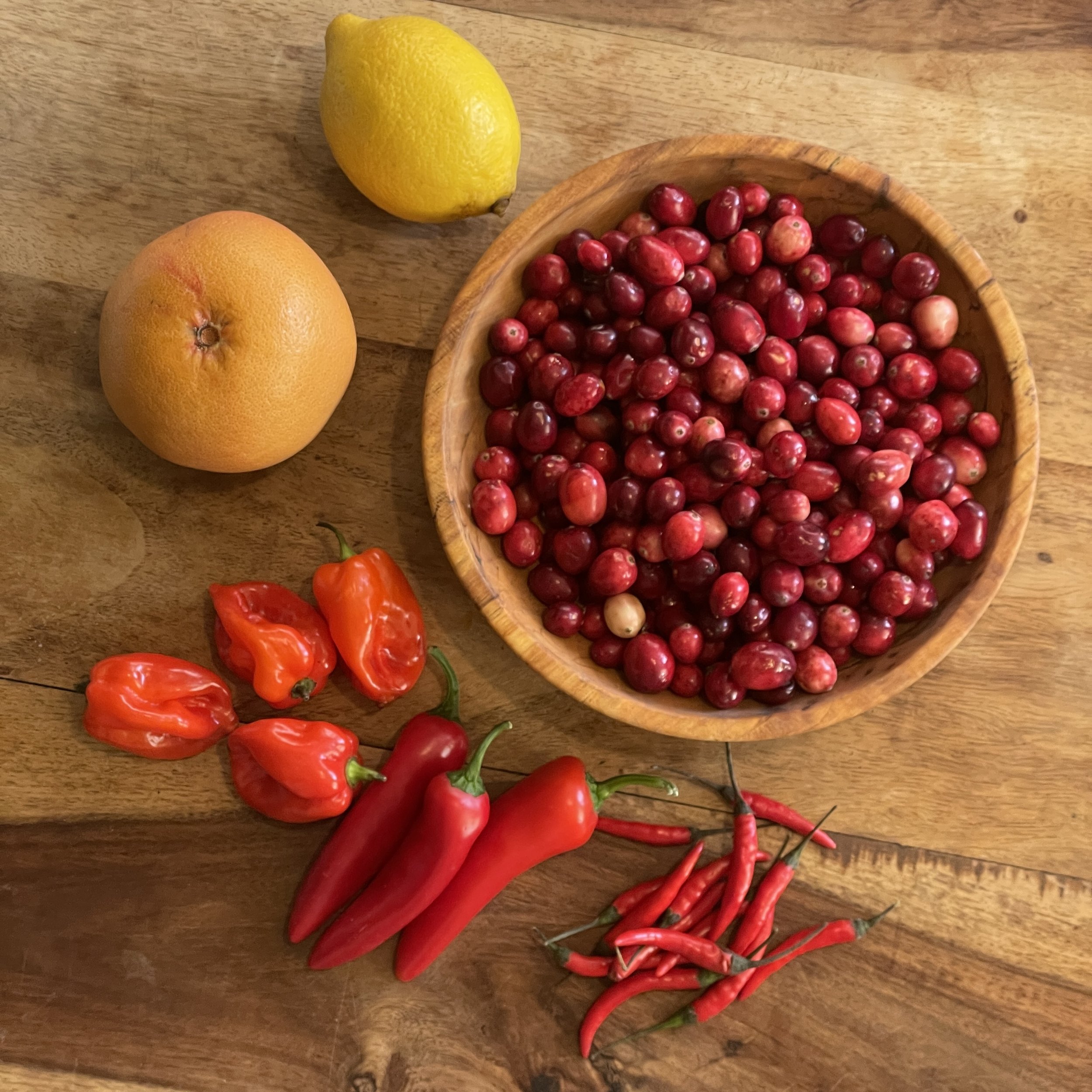…Cranberry & Citrus Kosho…
Ingredients for a cranberry & citrus kosho
This is a recipe based on the 'traditional' Japanese paste Yuzu Kosho, made with just 3 ingredients...
Yuzu, a member of the citrus family, tasting like a cross between lemon, grapefruit, and very sweet orange.
Kosho, the Japanese word for chili.
…and salt.
It is most often used in Japan as a condiment, in small quantities, to cut through rich fatty meats. Occasionally to marinade fish and shellfish, particularly if they will be eaten ceviche style. Also as a big flavour boost to season more bland dishes, like something simple with noodles and chicken.
However it is becoming more and more popular in the west, with restaurants sometimes serving it with steaks (like mustard); people putting it over vegetables; as a marinade for meats and fish prior to cooking - often reseasoned with more fresh at the end; to brighten up broths and soups. I've even had it with plain vanilla icecream - trust me, it really works, in a wonderful way.
Now some people may scream CULTURAL MISAPPROPRIATION at these latter uses. But I would happily point to the fact that chili peppers only reached Japan - from South America, via the Portuguese - in the mid 16th century, and even then they were primarily used decoratively, or (allegedly) occasionally crushed and put into socks to warm the feet in winter... It wasn't until the early 17th century they became more commonly used as a spice.
So I'm going to sidle firmly over to the side of CULTURAL APPRECIATION. Taking inspiration from the Japanese condiment Yuzu Kosho, and localising it with some of the traditional flavours from this time of year - many of which are also not actually traditional, native, or even able to be grown here. So let's go Christmas-ey… this will work wonderfully with cooked and cold meats, part of a cheeseboard (it is stunning with Wensleydale, feta and even halloumi) or a ploughman's lunch. So I'm going to put some spins on it - and also explain that I don't generally use my Yuzu Kosho as a paste, so I use a higher amount of the citrus juice, and have it more runny than traditionally.
Traditional Yuzu Kosho recipe
The zest and juice of yuzu fruit, kept separate.
Chilies, often Birdseye or small Thai, but you choose, finely chopped or minced. If you like hot chili flavour, go Scotch bonnets. If you have a more sensitive palate, Jalapeños. But do make it a touch more spicy than you would think to, as the heat does fade slightly as it ferments, and you want that burst of heat. I often mix my chilies for extra roundness of flavour/heat.
Salt.
Now generally you would mix the chilies and yuzu zest 50:50 by weight, and add juice to reach a thick yet moist paste, like mustard, leaving you with juice leftover, to use elsewhere. I prefer something thinner, so just tend to use all the juice.
To this paste, weighed, you add 10% salt. This sounds like a lot, but it's a condiment. You're not using much, and often it will act as your seasoning. So if you end up with 100g mixed yuzu zest, juice and chilies, you would need to mix in 10g salt.
Jar it up, and leave on the side somewhere safe, and out of direct sunlight, for roughly 48 hours. This allows the lactic acid fermentation to kick in.
Refrigerate, and use as you see fit. Experiment. It really is a remarkable thing to have to hand, I promise.
People often ask how long it keeps for... With 10% salt, and refrigerated, personally I would say indefinitely, or at least, it will keep for significantly longer than than it takes for you to use it, unless you're making huge amounts. So let's say a month. But if you spot any mould on top, discard it, and next time, make a slightly smaller quantity.
Cranberry and citrus kosho recipe
Cranberries, sorted, washed and finely chopped.
The zest and juice of your choice of citrus fruit, kept separate. I wanted to use clementines, as they're Christmas-ey, but I couldnt get any, so went with a mix of unwaxed lemon and pink grapefruit.
Chilies of your choice, finely chopped or minced.
Wintery spices. Maybe half a small cinnamon stick, or a couple of cloves. One whole star anise. Don't go over the top though. I chose to go with a few cloves and some ground allspice. Grind the spices if you want a stronger flavour, leave them whole for subtlety - and the ability to remove the spices if you want.
Salt.
As above recipe, but once you've mixed and weighed your citrus zest and chilies, add the cranberries to double the weight. So if your chilies and zest combined weighed 100g, make it up to 200g total weight with cranberries.
Add your spices, and then the citrus juice to get the desired paste consistency.
Weigh what you have so far, and calculate your 10% salt. So based on the 200g above, plus our juice, let's guess at 250g. So 10% salt would be 25g. Mix it in thoroughly.
As previously, jar it up, and leave somewhere safe, out of direct sunlight, for roughly 2 days. This allows the lactic acid fermentation to kick in.
Refrigerate.
If you do have a go at this, let me know what you think in the comments below. And do also let me know what your favourite way of using it was - do try it with some sharp cheese like decent Wensleydale or feta.
For me, the best bit about passing my knowledge and ideas to others is when I get to see it put into practice. So if you do try out your own version of any of the ideas you've seen in my posts, please share them with me on social media, tagging @cotswoldforager





